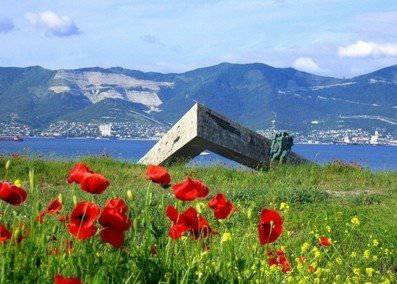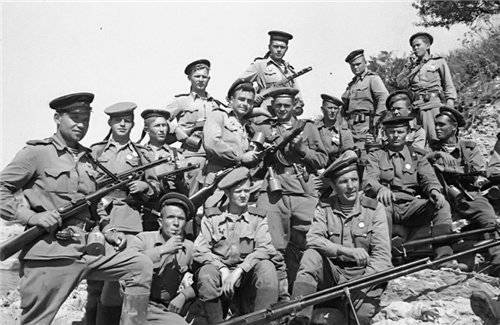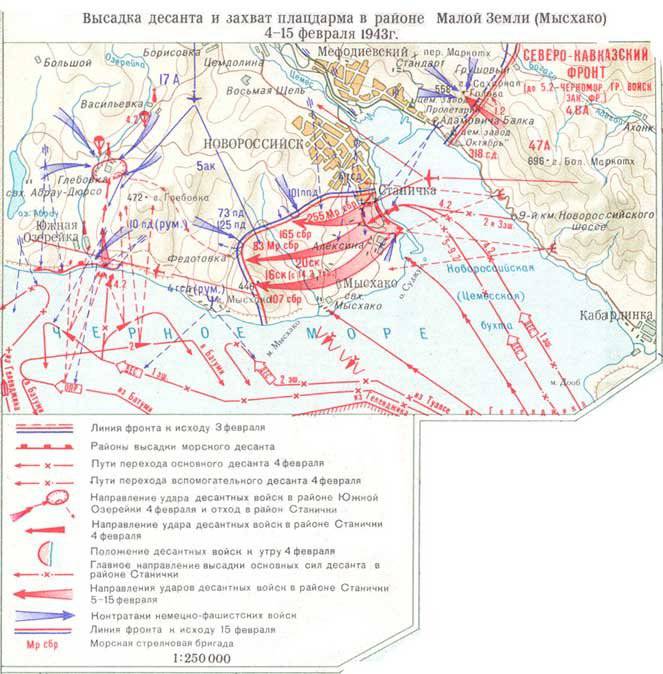The heroic page of the Great War - "Small Earth"
 On the night of 3 on 4 in February 1943, in the area of the village of Stanichka (southern suburb of Novorossiysk), a Soviet naval assault force commanded by Caesar Lvovich Kunikov (1909 - 14 in February 1943) was landed. So began the famous heroic defense of the “Lesser Land”, which lasted 225 days and ended on September 16 with the liberation of Novorossiysk.
On the night of 3 on 4 in February 1943, in the area of the village of Stanichka (southern suburb of Novorossiysk), a Soviet naval assault force commanded by Caesar Lvovich Kunikov (1909 - 14 in February 1943) was landed. So began the famous heroic defense of the “Lesser Land”, which lasted 225 days and ended on September 16 with the liberation of Novorossiysk. It all started with the fact that after the failure of Operation Edelweiss (the plan of the German command to seize the Caucasus, the oil-producing regions of Grozny and Baku), the Germans decided to seize Novorossiysk and further advance troops along the Black Sea coast towards Batumi. To accomplish this task, the 17 Army was allocated from the Army Group “A”, then they were reinforced with 3 divisions from the Kerch Peninsula, from the 11 Army.
Fending off the German strike, on August 17, 1942, the Soviet command created the Novorossiysk defensive area under the command of Major General G.P. Kotov. Initially, the Germans had a significant advantage over the Soviet forces: by tanks and to planes 2 times, in infantry 4 times, in artillery 7 times. The battles for Novorossiysk were very fierce. Parts of the 255th Marine Brigade ten days in a row repulsed the onslaught of the attackers coming from Neberdzhaevskaya and Lipok fascists, who also had a significant numerical superiority. As a result, the brigade was surrounded, but not one unit wavered, fulfilling the order: “Not a step back!” For example, the Germans surrounded the command post of the 4nd separate battalion 142 times under the command of Captain-Lieutenant Kuzmin and senior political instructor Rodin, and each time they rejected the enemy. Four days surrounded by the third company of the battalion under the command of political instructor Nezhnev repulsed 12 attacks, on September 6, the company broke through to their own. The brigade retreated only by order of the command, when the Germans after a fierce battle were able to capture the western part of Novorossiysk. From August 26 to September 7, the Marines destroyed more than 3 thousand soldiers and officers of the Wehrmacht, 5 tanks, 7 mortar batteries, 22 bunkers, 52 machine gun points and 24 vehicles.
Novorossiysk naval base was evacuated to Gelendzhik. On September 29, German troops on the Novorossiysk direction went over to the defensive and could not unite with the group advancing on Tuapse from the north. German troops managed to capture Novorossiysk, but they failed to use its port as their naval base, since the eastern part of Tsemesskaya bay was under the control of Soviet units, which completely controlled the approaches to the bay and the bay itself.
At the beginning of 1943, the Soviet high command was able to turn the tide in its favor: the elimination of Paulus's surrounded 6 Army near Stalingrad was completed; our forces attacked Rostov and Donbass; the blockade of Leningrad was broken through - operation Iskra; in the Caucasus, an offensive on the Maikop area was being prepared by the troops of the Black Sea Group under the command of General Petrov.
Operation “Mountains” began in the Caucasus - by 23 in January our troops broke through the enemy defenses south of Krasnodar, and the withdrawal of the German group from the North Caucasus was cut off. During the battles that lasted until the beginning of February, Soviet troops broke through to the Sea of Azov and captured Maikop. The time has come to carry out the second part of the operation - the offensive of the Soviet Black Sea Group by land with simultaneous landing of naval and airborne assault forces for a joint offensive on Novorossiysk (Operation Sea).

Marines from Major Ts. L. Kunikov’s squad shortly before they took part in a landing operation on the night of February 4 1943.
Landing force
The main landing was planned to land in the South Ozereyka area, distracting - in the Stanichka area. The main group included soldiers of the 83 and 255 brigade of the Marine Corps, 165 of the rifle brigade, a separate front-line airborne regiment, a separate machine-gun battalion, the 563-second tank battalion, the 29-second fighter-anti-tank artillery regiment. The distraction group included 275 marines, without the support of heavy weapons. Preparations for the landing began in November 1942. In general, the preparation was well organized, but the operation itself revealed a number of serious management deficiencies (consistency between different groups, landing synchronism, underestimation of the German coastal defense, etc.).
The airborne units were to disembark under the cover of the fire of support ships and the Air Force, suppress the resistance of the coastal defenses of the Germans, then connect with the paratroopers who had disembarked from the planes and break through to Novorossiysk. Thus, the German group in Novorossiysk wanted to block and then destroy by joint actions the main forces of the Black Sea group and the landing force. The immediate commander of the landing operation was Vice-Admiral Philip Oktyabrsky.
Operation “Sea” failed: German fire assets could not be suppressed, the ship’s landing was delayed — due to bad weather and loading arrangements, the ships’s departure was delayed by an hour — the Air Force command did not warn, and the planes launched an air strike and landed an airborne landing according to the original plan. Only a part of the landing was managed to land at Ozereyka, the Germans were able to quickly organize a repulse. The paratroopers at Ozereyka fought for three days, then those who did not die were divided. Part of it made its way to Stanichka, where an auxiliary landing force was landed, others, connecting with airborne troops, went into the mountains.
Auxiliary detachment acted more successfully. The ships reached the shore at the estimated time, were able to put a smoke screen. Under the cover of smoke and shipfire, the Kunikov paratroopers were fixed on the shore within an hour. Then the detachment expanded the bridgehead. At this point, the Soviet command could still turn the tide in their favor by shifting the brunt to the Stanichka area, landing units there that could not land at Ozereyka. But neither Admiral Oktyabrsky, nor the commander of the Black Sea Group of Forces of the Transcaucasian Front, General Ivan Petrov, accepted this decision, as a result, time was lost. When the situation was reported to the commander of the Transcaucasian Front, Ivan Tyulenev, he ordered the landing of new airborne units on the captured bridgehead and hold it by any means, but the effect of surprise was already lost.
Kunikov's detachment acted decisively, on the very first day a strip several kilometers wide was captured. The detachment was strengthened, its number was increased to eight hundred. The Germans were very active, they continued to conduct continuous artillery fire on the bridgehead, bombed them, the Nazis launched 18 counterattacks on the very first day, trying to throw paratroopers into the sea. In the first five days, the Soviet command transferred considerable forces to the “Little Land”, bringing the number of groups to 17 thousand. But the delay in transferring the main landing site played a fatal role, the bridgehead was expanded, but more could not be done. The Germans blocked the bridgehead. The Soviet command decided not to divert forces in order to use it subsequently, in more favorable conditions.
The Germans did not stop trying to throw Soviet troops into the sea. It was extremely difficult to hold the defense - by April it was a piece of land 8 by 6 km. The terrain is open, well shot, the Germans have in their hands all the surrounding heights. Soviet fighters had to literally dig into the ground - the whole bridgehead was dug in trenches, they built more than 200 observation posts, more than 500 firing points, and underground warehouses. In addition, it was very difficult to provide a bridgehead with ammunition, food, to supply replenishment, the Germans shot through all approaches, could strike at sea with the help of the special Boxing group (it included torpedo boats and submarines) and aviation.
In order to destroy the bridgehead, the German command formed from the 17 Army units an attack force of 27 thousand men under Wetzel's command (it included up to 500 guns and mortars, attached to 1 thousand planes). 17 April, the Germans went on the assault, the operation "Neptune" began. For three days, the artillery and aircraft beat almost non-stop, the infantry, with the support of the tanks, made one attack after another. Only on the first day did German U-87 dive bombers make more than 1,5 sorties. The seriousness of the situation is indicated by the fact that on April 10 Marshal G. Zhukov and Marshal A. Novikov, commander of the Soviet Air Force, arrived in the North Caucasus on 18. “Small Land” became another Stalingrad, a place where the German and Russian spirits met face to face.
In order to reverse the situation and not lose the bridgehead, the Soviet command had to transfer three air corps (fighter, mixed and bomber) from its reserve for air cover to its paratroopers. The Soviet Air Force was able to reverse the situation in the air, destroyed two German airfield. Only from 19 to 25 on April 152 of German aircraft was destroyed, as a result, the intensity of the German bombardment fell sharply.
There was a real air battle: 29 of April to 10 of May 1943 of the year in a relatively small area of the front in 30 km during the day occurred before 40 of air collisions. Great help to the Soviet Air Force had 5 radar, which promptly warned of the approach of Luftwaffe planes. The losses of the Air Force speak eloquently of rage and heat of struggle: from 17 April to 7 June, we lost 760 aircraft, the Germans 1100 (800 in air battles and up to 300 on the ground).
The fighting on the Little Land went for another three and a half months and stopped only after the liberation of Novorossiysk. September 9 began the operation of the Soviet troops on the capture of Novorossiysk, and the Kunikovsky bridgehead, which was conquered by February 4 of the year 1943, played its role. From the area of Stanichka, one of the three groups of forces that were blocking and liberating the city launched an offensive. After fierce battles to 16 September, Novorossiysk was freed from the Nazis. This day is also considered the date of the end of the defense of the bridgehead Small land. It lasted 225 days and deservedly became one of the brightest pages of the Great Patriotic War. Kunikov's paratroopers accomplished a real feat by immortalizing themselves.

Director - O. Beredin.
Information